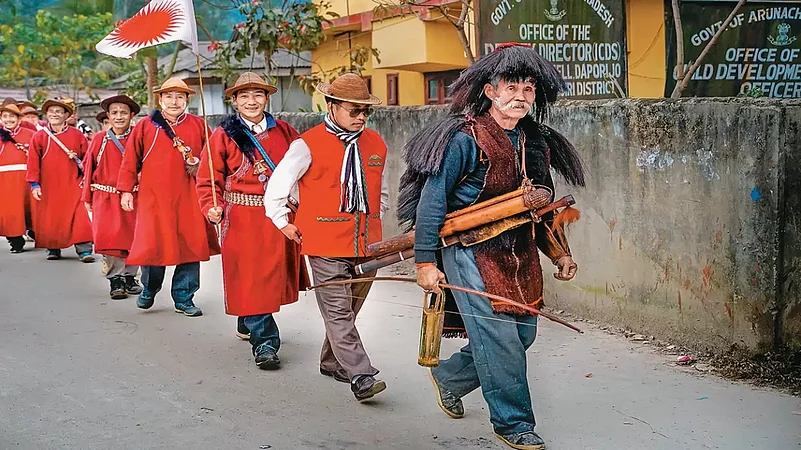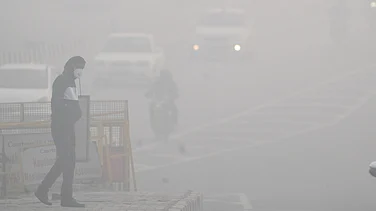If an Idu Mishmi wishes to hunt animals in the high mountains, he must first seek permission from Golon, the spirit of the high mountains, and promise to abide by all restrictions related to hunting. For the lower mountains and forests, promises must be made to Ashan, the guiding spirit of that region, before hunting or felling trees. If the spirits are offended by a breach of promise, misfortune would befall on the violator, family or neighbours, and it would require an Igu, the Idu shaman who negotiates with the spirits, to seek forgiveness.
Since time immemorial, as the Idus say, the Idu Mishmis have been great believers in spirits—of the high mountains, forests, rivers and household areas, among others. The aboriginal inhabitants of the Dibang River Valley region in central Arunachal Pradesh are traditional hunter-gatherers. But as local residents point out, their belief system was designed to develop and promote sustainable living.
“Take from the forests only what is absolutely necessary for sustenance is our guiding principle,” says Iho Mitapo, a young Idu in his 20s. Mitapo is involved with the Elopa-Etugu Community Eco-Cultural Preserve, a community conservation project near Roing town in Lower Dibang Valley district.
The Idus are one of the three tribes of the Mishmi group of people, the two others being Miju and Digaru. They speak Tibeto-Burmese languages and inhabit areas along the Indo-Tibetan border in Arunachal Pradesh. The Idus, with an estimated population of a little over 12,000, live in the Dibang Valley and Lower Dibang Valley districts.
One has to follow a number of rules and make other sacrifices to engage in hunting. For instance, if one has ‘forest blood’ in his hands, which implies killing a large animal, he is not supposed to engage in sexual relations for the next five days and not attend any social gathering. Hunting tigers and hoolock gibbons is prohibited, as Idus consider them their brethren.
Before starting the hunt, a ritual must be performed either by an Igu or by the hunter, and a ritual has to be conducted after successful hunting. A part of the animal’s body and a piece of metal is ‘paid’ to the spirit, promising that restrictions will be followed and urging not to bother the hunters any further. There are restrictions regarding bathing and washing clothes, too.
For all breaches of promises made to the spirits that are seen to have brought misfortune to the people of their neighbourhood, the Idu Mishmis need the Igu to pacify the spirits. Igus are required in all important occasions—from birth to death ceremonies and festivals to healing procedures. But over the past few years, the number of Igus has dwindled so much that many villages do not have an Igu of their own.
Noting that the younger generation was no longer showing interest in priesthood, the Idu Mishmi Cultural and Literary Society (IMCLS) opened in 2020 the Idu Mishmi Shamanic School, to train Igus, at Alinye, a village at 5,400 feet elevation with a population of about 200, seated less than 50 km from the Indo-China border. The school has four youths, aged between 25 and 35, who are learning the language, customs and rituals. They receive a monthly stipend and are supposed to return to their native villages on completion of training.
“Modern education and economy created a disconnect between the young generation and our culture, value system and practices. The young ones mostly study in boarding schools outside and have lost interest in our traditions, even language. The sustainable lifestyle that our value system preaches is forced to make way for a profit-oriented worldview,” Rajiv Miso, an Idu Mishmi scholar, tells Outlook. Miso teaches history at a college in Arunachal Pradesh. “The decline in the number of Igus will ultimately result in the vanishing of the ancient, sacred oral narratives and knowledge of the community,” says Miso, who is also a member of the IMCLS.
The community conservation project that Mitapo is involved with is also an attempt towards the same goal—protection of forests and wildlife means protecting the Idu lifestyle. Sprawled over 65 sq km, it is supposed to serve as a community-run wildlife sanctuary, where community-approved need-based hunting would be allowed. “[W]e plan to conserve, research, manage and use sustainably—in accordance with Idu Mishmi tradition, informed by scientific knowledge, and with an eye to our rapidly changing world,” the official declaration reads.
The majority of the Idu Mishmis identify themselves as animists. But about one-third of them also identify as Hindus, who worship their spirits and deities like Shiva. Christianity, which has often walked hand-in-hand with modernity in aborigines-inhabited northeastern states, is yet to make inroads into the community.
The same is not true for the Adi people, one of the largest tribes in the state, who live in Lower Dibang Valley, East Siang, West Siang and Upper Siang districts. Christianity gained grounds in the Adi belt of the Siang River Valley since the early 1970s and about one-fourth of the Adis are estimated to have converted to Christianity. It is through their prayers for the ill, locals say, reaching the smallest of huts in the remotest of the villages that Christian missionaries won the Adi people over to their faith.
This had resulted in a revivalist or restoration movement among the animist believers belonging to the Adi, Tani, Karbi and Galo tribes, culminating in the institutionalisation of the indigenous faith as Donyi-Polo religion, named after the sun and the moon. Gradually, congregation centres or gangings were built at several places and oral history, knowledge and customs were documented. Despite these attempts, the share of Christinity among the population in this region kept increasing.
In East Siang, the 2011 Census identified nearly half the population as believers in indigenous faith, while 28 per cent were believers in Hinduism and 18.4 per cent in Christianity. In West Siang, 53.45 per cent of the population was identified as believers of indigenous faith, while 26.69 per cent were Christians. The indigenous faith is more dominant in Upper Siang, nearly 60 per cent, while about 16 per cent and 15 per cent identify themselves as Christians and Hindus, respectively.
Bomdeng Taga, a young Adi doctor at the Pasighat hospital in East Siang district, who comes from a Christian family, threw some light into how Christianity won over a section of the Adis. According to her, Christianity, even while believing in miracles, also represented modernity. “The old religion is a little violent. Rituals like animal sacrifice are now considered outdated. The Christians stress on prayer but also ask one to go for modern medicine. Funerals in our animistic religion go on for one to two months. One has to stay home as long as the priest asks,” she says. The practices of Christianity are easier, she adds, whereas those of their ancient religion are rigorous.
A young entrepreneur from Pasighat town, who did not want to be named, said that marriage restriction is another reason the young generation is looking away from the old religion, which prohibits intra-clan marriage. The ideal marriage is between people from different clans in the same tribe. “Besides, the healing procedures appear quite crude to many of us who studied in schools providing modern education,” he says.
Many of those who have become Christians also take part in their traditional festivities but observe the birth and death ceremonies the Christian way. They also avoid the indigenous healing customs.
The advancement of Christianity has also led to certain social tension in the state in recent years. Social Justice Forum of Arunachal Pradesh, a non-government organization, regularly highlights the alleged Christian attempts to demean the indigenous faith. There have been demands for creating an indigenous faith department by the government, a proposal that Christian social organisations protest.
In Sikkim’s Dzongu Valley, however, Buddhism has smoothly blended with the indigenous Lepcha faith. Most of the Lepchas are Buddhists, but every ceremony starts with the Bunthim, or the Lepcha priest, performing the Lepcha rituals first. Buddhist monks take over thereafter.
“We are Lepchas first, Buddhists later,” says Ong Tshering Lepcha, general-secretary of the Sangha of Dzongu. According to him, since Guru Rinpoche, one of the founding fathers of Tibetan Buddhism, instructed protection of nature and wildlife, Buddhist teachings have smoothly blended with the nature-worshiping Lepcha way of life.
The Lepcha faith has many religious events—the worship of jungles, crops, wealth, to stop hail storms and to prevent illness in summer. In their worship rituals, the mantra includes the names of all hills and rivers in the neighbourhood, where their deities live.
(This appeared in the print edition as "Guarding Indigenous Faith")
Snigdhendu Bhattacharya in Arunachal Pradesh and Sikkim


























